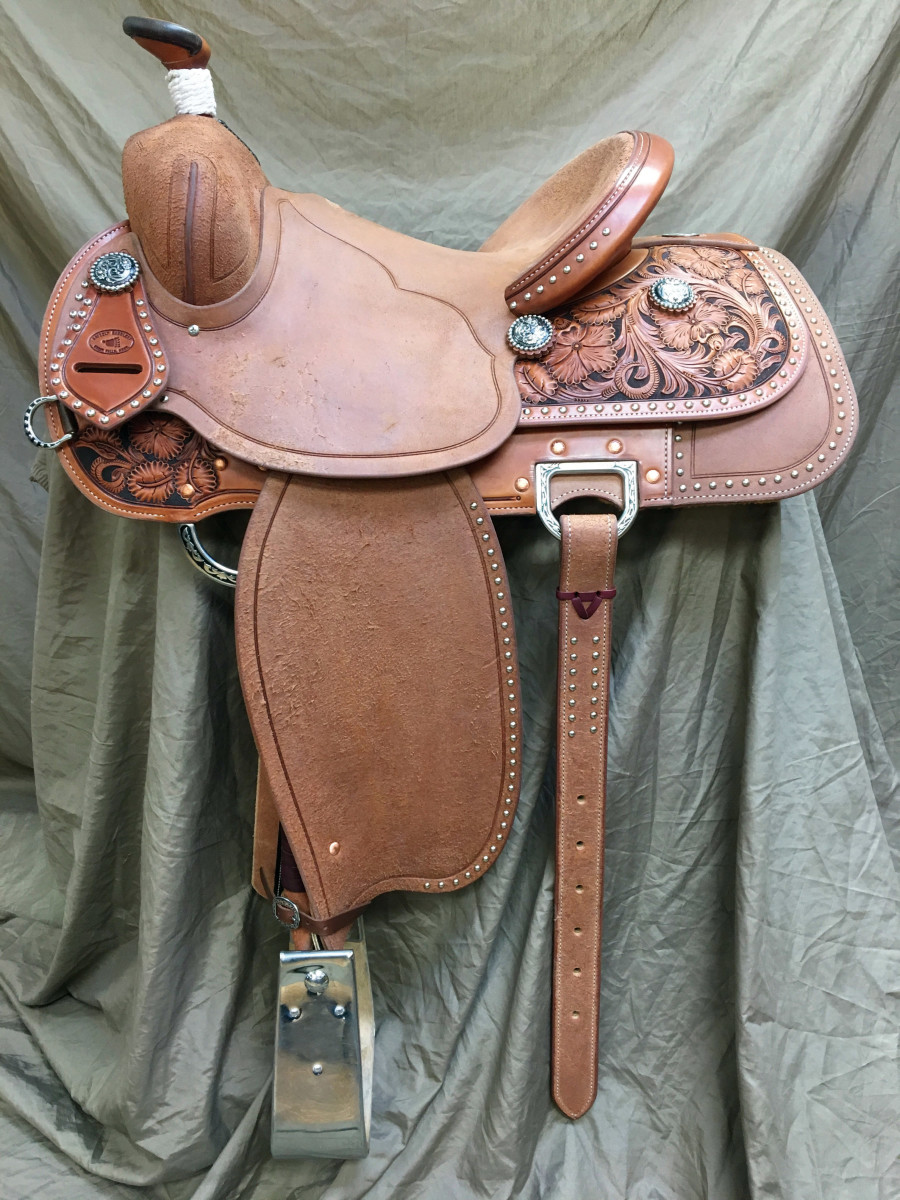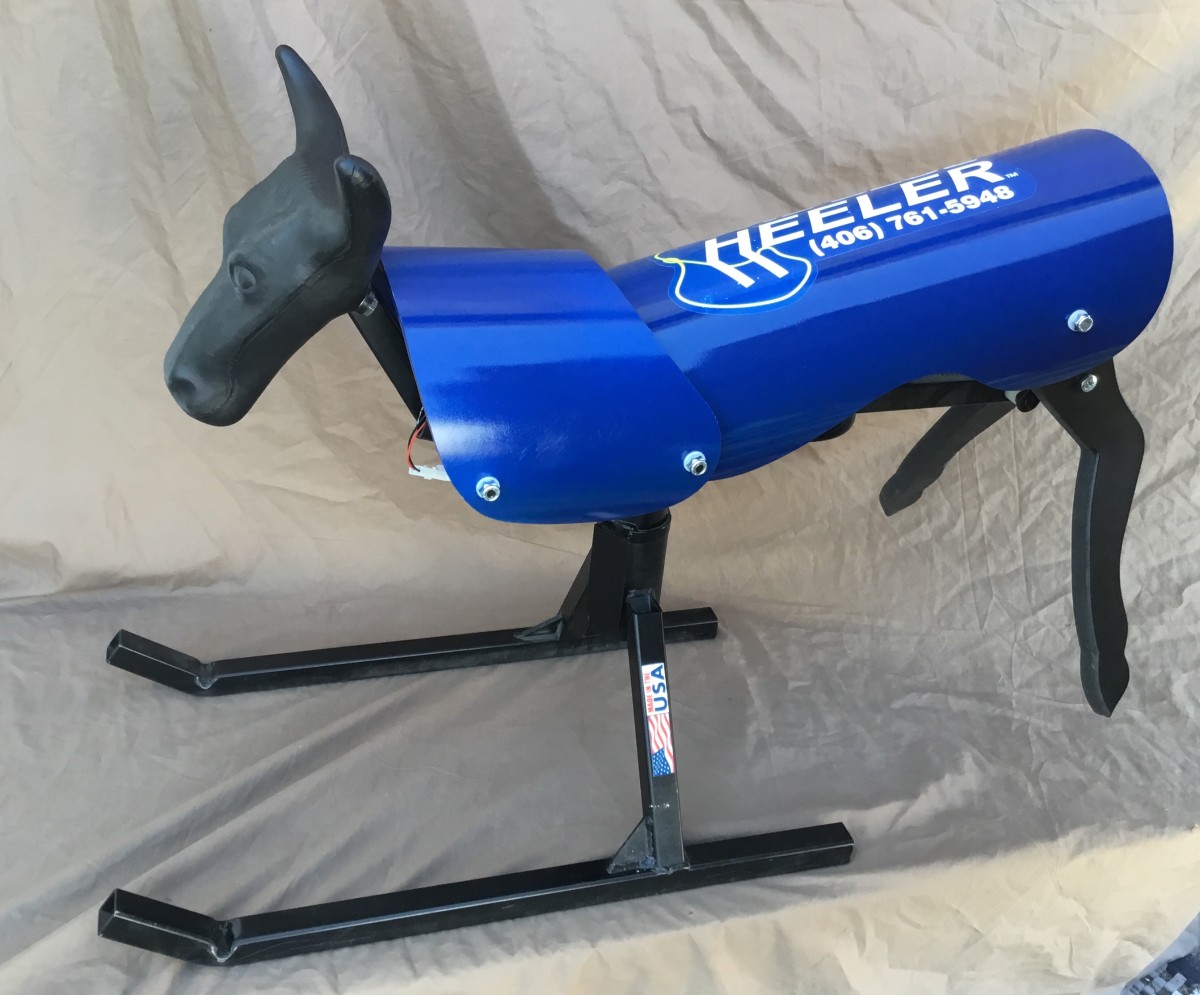The Making of a Saddlemaker
Jeff Gollehon, 57, was maybe 9 years old when his dad took him to Jesse Bleaker Saddlery to watch the man build a custom saddle Gollehon’s dad had ordered. The young boy was hooked.
“My dad had custom saddles made because he trained horses and rode all the time, and he had to have good equipment. He took me to the saddlery and, watching that and seeing how it started with just a couple slabs of leather and a sheepskin and a wooden tree, it was basically like a blank canvas for an artist. Just raw material. It blew my mind.”
That experience, coupled with finding a Tandy kit at home a few years later, rebuilding old saddles with his dad, and then being able to do some leather work in a high school arts and crafts class cemented the deal for Gollehon, who worked with his guidance counselor to figure out how to go to school for the craft after graduation.

Courtesy of Grizzly Saddlery/Lil’ Blue Heeler
In the fall of 1980, Gollehon and Rhonda, his high school sweetheart of six months, moved away from his hometown of Fairfield to Spokane, Washington, where they married and Gollehon enrolled in a two-year saddlemaking course at the local community college.
As it often goes with well-laid plans, though, the college decided to double its tuition for out-of-state students just before the Gollehons were set to return to Washington after a summer at home following the first year of the course.
“I had all my money set up and some student loans and grants through the first year of school,” Gollehon said. “When I got done with the first year, I came home and Jesse Bleaker, the guy that built my dad’s saddle had said, yes, if you go to saddlemaking school, you can come back and help me repair saddles.
“Well, in August, I got that letter from the college saying that tuition had doubled. I only had 30 days to try to come up with twice as much money as I had originally planned. For my wife and I it was devastating, but it was kind of a blessing in disguise because I got to stay and work at that shop and maybe didn’t learn quite as much as far as artistic ability, but I learned a lot more about structure and how things go together, and I got to build more saddles in the same amount of time as I got to in the saddlemaking school.”
It was a change of plans that Gollehon now considers a blessing.
“That really did work out the way it was supposed to. The good Lord was watching over me and that was really my destiny.”
Building a Saddle Shop and Business
After spending more than a year at Bleaker’s, Gollehon was hired on at Grizzly Saddlery in Great Falls, Montana, not too far from home and, after a while, he began to see a real opportunity.
“The person who owned Grizzly for the nine years before me was an elderly gentleman, and he got to the point where he wasn’t getting as much work done as he should, and orders were falling behind and he started losing customers. I could see there was a gold mine lying under the blankets there, and I could see where the business could grow in leaps and bound if I could get my hands on it.”
The opportunity came and Gollehon, with his wife and his mother, purchased Grizzly Saddlery, which has historic ties to the Victor Ario Saddlery, which was established in Great Falls in 1897. In the time since, the saddlery has changed owners and locations, but some of its traditions remain in practice today.
“We still have lots of the hand tools, sewing machines, the leather splitters. Lots of the tools that are used to decorate leather are those original tools from that original store. Every day that we work, we use those tools.”
Gollehon and Rhonda have spent nearly every day of the last 25 years working next to each other in the shop and raising their family. Gollehon’s mother built chaps for 20 years, and Rhonda runs the tack shop and helps her husband with saddle repairs and custom builds, too, but none of it came particularly easy.
Speaking to how his experience under the previous Grizzly owner hadn’t provided him with much business savvy, Gollehon said, “They had just stuck me in a little room and fed me leather and trees and I built saddles for almost 10 years. That’s all I really knew. I didn’t have any hands-on experience making the business work.”
It wasn’t long before he was working seven days a week, trying to build just as many saddles as he had been, but also giving his customers the time they needed, not to mention handling the billing and ordering supplies and all of the other things running a business actually requires. Then, after they moved shop to a new location in town, the city shut down the streets on their block for six months of road repairs.
“That second year was a really scary time,” Gollehon remembered. “The way that we really made it was, I had a backlog of about 20 custom saddles and even though we didn’t really have anybody walking through the door to do business, I had the time needed to work on saddles. So, I busted butt on 20 saddles, made the payments, and then they opened our street and from then on it was good.”
From Builder to Craftsman
As a team roper and trainer, Gollehon puts a lot of pride in crafting equipment that not only lasts, but serves the person in the saddle, and the job they need to do.
“When we build a saddle for a customer,” Gollehon said, “I strive for perfection every time. That’s where we really try to shine. When you take it home, you don’t have to monkey with it. It works. You ride it, you put it on the rack, and when you come back the next time it does exactly the same thing it did the time before.”
Gollehon puts a lot of emphasis on making the saddle work for the rider and its ability to make the rider’s job easier.
“The biggest thing that I see with so many factory saddles on the market and what a custom saddlemaker can do, the riggin is the most important thing in getting a balance between rider, horse and saddle. Many factory saddles don’t have the right cantle height—so you have a good support behind you—and where the fender or the stirrup placement is. The correct riggin, the correct cantle height, and the correct fender placement are probably the three most important things as far as I’m concerned.”
Gollehon points to his wife—with whom he also partners in the roping arena—as an example, admitting that though she might be somewhat biased, after 38 years of marriage, she wasn’t going to sugarcoat her feedback either.
“Rhonda was riding a saddle that she had won. The riggin wasn’t built well, and the seat and the position was not conducive for her to be balanced and rope well. It was harder for her to do her job.”
Eventually Rhonda grabbed a saddle Gollehon had built for himself on a day he wasn’t roping, and it wasn’t long before he had to build Rhonda her own saddle.
“There’s 10 different things that I can do to our team roping saddles that you would never get on something you could buy off the rack. It’s just the way it is.”
What’s Old is New: Horses and Heeling Dummies
Gollehon was 8 when he roped his first cow off his horse, and he pursued the sport through high school and did some amateur rodeoing, but as he and Rhonda committed themselves to the business, the focus shifted to raising the girls horseback.
“We were married when we were 18, so we got away from horses because we didn’t have any money, and then we had kids. We roped a little bit at home, but we never really did much jackpotting because you don’t really have a lot of extra money when you’re supporting a family.”
Plus, he added, “back when I was growing up, there was no such thing as a number system and you just roped with the wolves and they took your money.”
Now, the Gollehons rope within a 100-mile radius on the weekends and make a point of getting to Billings once or twice a summer to rope in Ty Yost’s summer series. Then, each winter, they carve out two weeks to rope in Arizona. And, they’re not exactly talking about retiring.
Six or seven years ago, Gollehon began marketing his family-friendly roping dummy, the Lil’ Blue Heeler.

As a kid, somebody had gifted Gollehon a Happy Hopper—a wooden, motorized dummy Walt Woodard had engineered to help his roping school students understand timing—and he learned to rope on it. One winter, he pulled it out and tried to rejuvenate it for his girls, but it had passed its prime, so he built one of his own, made of metal and plastic.
“One year, we went to the NFR with it, and that was the beginning of the end. We’ve started going every year and selling 100 machines there.”
Gollehon knows there’s room to grow the Lil’ Blue Heeler business, but so long as their saddlery keeps doing as well as it is, that’s the way things will remain. Not to mention, Gollehon has another dream up his sleeve.
“I’ve never bought a Pro card,” Gollehon said, “but I’ve always felt that I could be competitive. That was always one of my goals. When I was young, I had kids and I really couldn’t dedicate any time to really practice up to the level that I’d want to get to to buy my Pro card. But, I would really like, before I get too old, to see if I could make it. Not necessarily go full time, but I would like to go see if I could make it in the state of Montana as a professional roper.”
For more information:
grizzlysaddlery.com
406-761-5948










